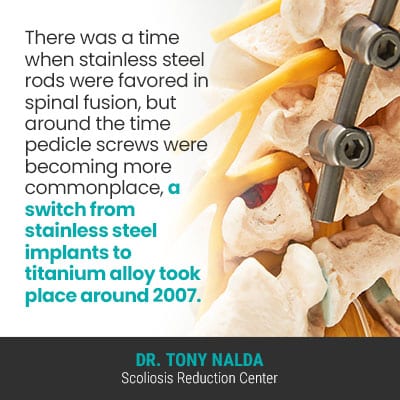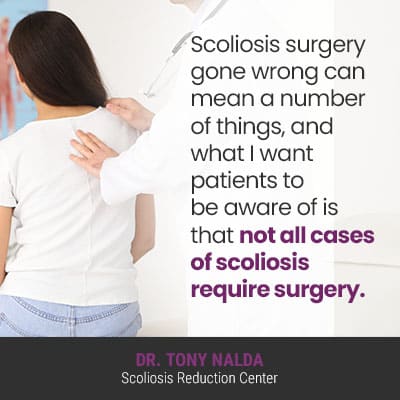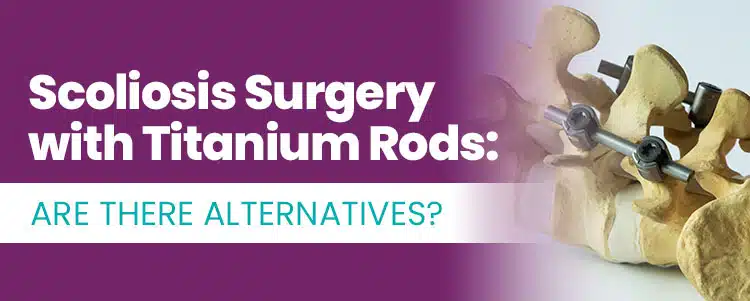It’s important that patients are aware of all scoliosis treatment options available so they can ensure the chosen treatment approach is aligned with their desired outcome; different treatment methods affect the spine differently, and the choice of one type of treatment over another can impact overall quality of life.
Also known as spinal fusion, scoliosis surgery commonly involves the use of titanium metal rods that are attached to the spine with pedicle screws. An alternative to scoliosis surgery is modern conservative non-surgical treatment.
Scoliosis is a progressive condition, so how a diagnosis is responded to with treatment is particularly important; let’s start with why.
Being Diagnosed with Scoliosis
Being diagnosed with scoliosis can be an overwhelming time, but with the appropriate treatment, scoliosis neither has to define a person, nor limit their potential.
In fact, there are a number of famous people, including professional athletes, who continue to thrive, despite being diagnosed with the progressive spinal condition.
A scoliosis diagnosis means an unnatural spinal curve with rotation has developed, and the rotation makes the condition 3-dimensional because a scoliotic spine doesn’t just bend unnaturally, it also twists.
Scoliosis is also a highly-variable condition that ranges widely in severity from mild to moderate and severe to very severe.
Condition severity is determined by a measurement known as Cobb angle, and a patient’s Cobb angle is taken during X-ray by drawing lines from the tops and bottoms of the curve’s most-tilted vertebrae.
The resulting angle is expressed in degrees, and the higher a patient’s Cobb angle, the more severe the condition, and the more noticeable the conditioln’s effects are likely to be.
The condition’s main effect in children is postural deviation, and this is due to the condition’s uneven forces disrupting the body’s overall symmetry; this can include uneven shoulders, shoulder blades, the development of a rib arch, uneven hips, and arms and legs that appear to hang at different lengths.
Additional changes to watch for are disruptions to balance, coordination, gait, and clothing suddenly seeming ill-fitting.
The main effect of scoliosis in adults is pain, and this is because scoliosis becomes a compressive condition in adulthood, and it’s compression of the spine and its surrounding muscles and nerves that causes the majority of condition-related pain.
Being diagnosed with scoliosis means a decision has to be made: how to treat it moving forward.
Scoliosis Treatment Options
When it comes to scoliosis treatment options, there are two main approaches to choose between: traditional and conservative treatment.
Traditional scoliosis treatment was the dominant choice for many years, and it offers a surgical response to scoliosis, while modern conservative treatment offers a non-surgical treatment alternative.
Traditional solosis treatment doesn’t have a strategy for addressing scoliosis while mild so does little to prevent progression, which is why it’s commonly described as a more reactive, than proactive, response to scoliosis.
Conservative treatment strives to prevent progression with proactive treatment, whereas traditional treatment reacts when/if a patient’s scoliosis progresses into the severe classification, when it commonly recommends spinal fusion.
Scoliosis Surgery with Titanium Rods
Spinal fusion has the goal of stopping progression, which is why the procedure involves fusing the curve’s most-tilted vertebrae into one solid bone, and this also involves the removal of intervertebral discs that sit between adjacent vertebrae to be fused.
Next, rods are commonly attached to the spine with pedicle screws to hold the spine in place throughout the fusion process and beyond; hardware attached to the spine is permanent.

There was a time when stainless steel rods were favored in spinal fusion, but around the time pedicle screws were becoming more commonplace, a switch from stainless steel implants to titanium alloy took place around 2007.
The use of titanium was favored over stainless steel because of the high biocompatibility of titanium, its high resistance to corrosion, and being able to perform X-rays with metal interference; its cons included being prone to notching post bend-deformation and decreased stiffness.
Ultimately, studies have shown that while there are minor differences in rod function between stainless steel, titanium, and cobalt chrome, there is no statistical difference in rod deformation between the different types, and the use of titanium over cobalt chrome is more cost-efficient.
Potential Complications of Scoliosis Surgery
Like all surgical procedures, spinal fusion comes with some heavy potential side effects, risks, and complications.
Remember, hardware attached is permanent, but what happens if the hardware fails, or reaches its natural longevity?
There are complications associated with both the procedure itself, and long-term complications that are associated with living with a fused spine.
Some complications associated with the surgery itself can include:
- Nerve damage
- Injection
- Excessive blood loss
- Adverse reaction to hardware used
Some complications associated with living with a fused spine can include:
- Decreased range of motion
- Decreased spinal flexibility
- Increased pain at the fusion site
- Nerve Damage
- A spine that’s weaker and more vulnerable to injury
- Psychological effect of living with a fused spine (fear to try new things)
- Hardware failure over time
- The need for subsequent surgeries
As you can see, there are some serious potential surgery complications, and while every patient is going to respond to spinal fusion in their own way, these risks are there, so should be considered carefully.
Non-Surgical Scoliosis Treatment

Scoliosis surgery gone wrong can mean a number of things, and what I want patients to be aware of is that not all cases of scoliosis require surgery.
Here at the Scoliosis Reduction Center®, I treat patients with a conservative chiropractic-centered treatment approach that has produced some impressive results.
I want to help patients avoid the need for invasive surgical treatment because I feel a non-surgical response is what gives patients the best possible quality of life because its approach is aligned with the spine’s natural design and function, unlike spinal fusion surgery.
I combine multiple condition-specific treatment disciplines into treatment plans so conditions can be impacted on every level: chiropractic care, physical therapy, corrective bracing, and rehabilitation.
I use chiropractic care to work towards achieving a curvature reduction on a structural level; a series of techniques and manual adjustments can help adjust the position of the curve’s most-tilted vertebrae back into alignment with the rest of the spine.
Through physical therapy, I help patients increase their core strength so their spines are optimally supported by its surrounding muscles, and physical therapy can also help improve posture, address any related muscle imbalance, and activate the brain for improved brain-body communication.
Corrective bracing is particularly effective on growing spines so can be a common facet of treatment for the condition’s most-prevalent type: adolescent idiopathic scoliosis, diagnosed between the ages of 10 and 18.
With the treatment of adolescent idiopathic scoliosis, a focus is on achieving a curvature reduction and holding it there throughout growth because growth is the condition’s trigger for progression, so efforts need to be made to counteract the constant trigger of growth and development.
Rehabilitation is an ongoing process that involves a series of custom-prescribed home exercises for further stabilizing and healing the spine.
Conclusion
When it comes to scoliosis surgery with titanium rods, we’re talking about spinal fusion surgery, and an alternative is non-surgical conservative treatment.
Traditional scoliosis treatment favors a surgical response, but prior to spinal fusion, little is done to work towards preventing progression, which is why it’s commonly described as more reactive than proactive.
Conservative treatment is proactive, which is why it starts treatment as close to the time of diagnosis as possible; it’s far more effective to work towards preventing progression and increasing condition-effects, than it is to attempt to reverse those effects once they’re established.
While there are never treatment guarantees, with scoliosis that’s detected early and responded to with a proactive treatment plan, there are fewer limits to what can be achieved.
Scoliosis surgery is a risky, invasive, and costly procedure, and while spinal surgeons have their patients’ best interests at heart, the way it affects the spine in terms of its overall health, strength, and function is contrary to its natural movement-based design.
The main effect that many patients are disappointed with is the reduced range in motion and spinal flexibility that a fused spine can cause, and this can cause activity restrictions, increased pain levels, and also impacts a person’s mental health as awareness that one’s spine is more vulnerable to injury can cause fear of trying new things, or even participating in once-loved activities.
Here at the Center, I’ve been successfully treating scoliosis without surgery for over 20 years, so if you’re looking for an alternative to invasive surgical treatment, don’t hesitate to reach out for guidance and support.




